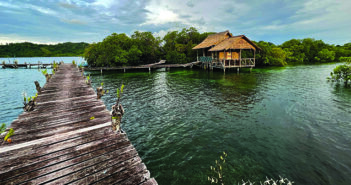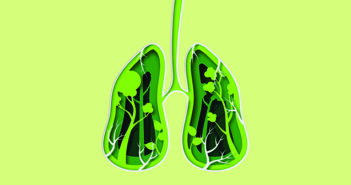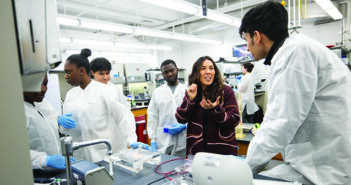Humans weren’t made to live indoors. Could a dose of nature be the cure for what ails us?
Pooja Tandon ’96 MD’99, MPH, can still vividly recall the day more than 10 years ago that transformed her research on child health.
A pediatrician and University of Washington professor in Seattle, she had brought her boys, who were 2 and 5 at the time, for a day at the beach. As they dug intently in the sand for hours, Tandon dug into her book, Last Child in the Woods, in which author Richard Louv coins the term “nature-deficit disorder” to describe how our society’s decreasing exposure to the outdoors harms children and all of us.
As she read—without interruption, for the first time in years—Tandon thought back to the times her sons and other kids would act out after too much time inside, yet they behaved and played nicely when they could go outside and “move their little bodies.” She remembered her very urban upbringing in Lucknow, India, where she nevertheless spent most of her time outdoors, on her grandparents’ rooftop terrace, soaking up the sun on cool winter days and sleeping “under the stars” when it was too hot inside in the summer.
The book, and her experience reading it, were “transformational,” Tandon says. “I was sitting at a beach with my kids playing uninterrupted for a long stretch, and really recognizing that, wow, there’s something to this that has made parenting easier for me, while promoting our health and our well-being, for both of us.”
Preventive medicine drew Tandon to medical school, she says, and she chose pediatrics “because of this immense capacity to influence health early in life.” She was already studying and promoting physical activity for kids when she read Last Child in the Woods, so investigating the health benefits of time outdoors and in nature was a logical extension of her research.
“As a scientist myself, I was curious. Although this feels like the right thing, what is the evidence around it?” Tandon recalls thinking. She knows firsthand how little time clinicians have with each patient, how they must prioritize what topics to discuss and what advice to give in each encounter. “We want to focus on things that are evidence based and are going to influence health,” she says.
Tandon and some colleagues combed through the literature on nature contact and health. They found hundreds of studies, of adults and of children, but no systematic review of the research on kids’ health. So they wrote it. Their 2021 paper, published in Pediatrics, includes almost 300 articles and categorizes different types of exposure to nature and their health outcomes. The findings were overwhelmingly positive.
“The list of benefits of outdoor time for children and adults is long, and it includes things like healthier vitamin D levels, healthier weight status, better concentration for those with ADHD, lower blood pressure, lower stress,” Tandon said in a 2023 TEDx Talk. Time in nature also correlates with less depression and anxiety; better pregnancy outcomes; even lower rates of nearsightedness.
“That systematic review definitely was the foundation of what I’ve been able to do since then,” Tandon says, including her recent book, Digging Into Nature: Outdoor Adventures for Happier and Healthier Kids, coauthored with Danette Swanson Glassy, MD, and published by the American Academy of Pediatrics.
Yet Tandon is wary of a blanket prescription for nature. People are busy; some don’t have safe spaces outside near their homes. “Equity in access to green spaces and nature is an important part of promoting health equity,” she says. Plus there are health risks outdoors: air pollution, wildfire smoke, allergens like pollen, extreme heat and cold, insect bites and stings, and poisonous plants, to name a few. Some people have physical limitations that may restrict their access. Others have experienced trauma outdoors, or may feel unwelcome or unsafe.
But Tandon believes these barriers are surmountable—and though it may look different for each person, we all deserve to enjoy the outdoors. Even a short walk each day can reap big rewards for our health.
“There is a way that being in nature is possible for everyone,” she says.
Though promoting nature exposure for human health has gained momentum in recent years, awareness of the connection is not new. Hippocrates suggested that fresh air and natural environments are good for us; Ayurvedic practitioners, Celts and Druids, Taoists, Buddhists, and monks of the Middle Ages all touted trees, plants, gardens, and forests for their healing properties.
There’s a certain obvious logic to this connection: “The outdoor world, historically, as human beings—that’s our natural environment,” says Mariah Stump RES’15, MD, MPH, the director of the Medical School’s scholarly concentration on Lifestyle Medicine and Integrative Health. In nature, “we’re using different parts of our brain. And it’s a very ancient part, because we’re anciently wired for that. But we’ve tuned all of that out, because we’re so tuned into our devices.”
Christopher Moore, PhD, the associate director of Brown’s Carney Institute for Brain Science, agrees. “Our brains were made to respond optimally to certain kinds of stimuli in the world we evolved [in],” he says. Mammalian brains release dopamine in response to basic biological triggers: eating, spotting a potential mate—even just looking at nature. “Dopamine systems are triggered when you see natural scenes,” Moore says.
For decades researchers have observed the small but noticeable therapeutic effects of nature for hospital patients, such as shorter hospital stays and reduced pain medication usage in surgical patients who could see trees out their window, instead of a brick wall, according to a 1984 paper in Science. More broadly, nature exposure—which includes not only physical immersion in natural areas but even photographs and virtual reality—correlates in study after study with better sleep, fewer PTSD and ADHD symptoms, and lower rates of stress, anxiety, and depression. Other studies have found that young children who play outside have considerably lower rates of myopia.
Meanwhile researchers of forest bathing—the centuries-old practice of immersing oneself in the woods to improve wellbeing—have recorded significantly higher natural killer cell counts among practitioners, which lasted for days or weeks afterwards. The effect may be due to antimicrobial volatile compounds emitted by plants called phytoncides, which have been used in traditional medicine around the world for centuries. Phytoncides are now a hot area of research, with evidence of beneficial effects ranging from lower stress and anxiety to tumor suppression.
Stump notes that until a couple of centuries ago, most people lived in rural areas, and worked and spent most of their time outdoors. Now more than half of the world’s population lives in cities; the average American spends about seven hours a day staring at screens. “We just aren’t built for this,” she says.
Last fall, Brown hosted Nature and Health, a three-day workshop that invited researchers from across the US and the globe to explore the natural world’s effects on our health and well-being, from the cellular to the societal levels. Moore, who was a member of the steering committee, says Brown’s intrinsic multidisciplinarity made it “a fabulous place” for the engineers, social scientists, primary care physicians, computer scientists, psychiatrists, neuroscientists, and other experts to gather and share ideas.
“One of the fantastic things this meeting surfaced is that the problem of nature and health is one you simply cannot address at a single level,” he adds. “Brown’s good at thinking about systems in complex ways.”
A neuroscientist, Moore studies rodents to understand how the systems of the body, both neural and non-neural, work together to perceive the world. At the conference, he talked about how by modestly enriching lab mice enclosures—allowing them to touch and explore freely, interact with other mice, even face some minor challenges—he and his team observed “dramatic transformations” in their brains, including new synapses and blood vessels. The stimulation of dopamine axons briefly opens the blood-brain barrier, which seems to help with learning and lets the brain clear out waste.
“It’s not subtle,” Moore says of the brain changes. “To be clear, we didn’t do much” in terms of changing the environment—the mice were still in lab enclosures. Yet he believes their studies suggest that our brains are optimized in a naturalistic, complex world. There is “something rich and interesting about natural environments for our health. And it’s not just something; there are endless dimensions of this,” Moore says.
Workshop participants also discussed alternatives to being in nature, from looking out a window to VR experiences. Kelly Holder, PhD, another steering committee member, says these inspire her, in her role as chief well-being officer for the Division of Biology and Medicine, to bring nature into the Medical School in the form of photos and live plants.
“While we do have the natural benefits from the physical properties of plants and the fresh air, we also get something from looking at nature,” Holder says. She’s also shared with students an app that was presented at the workshop called NatureDose, which measures an individual’s time in nature. “When we observe a behavior, it aids us in changing that behavior,” she says.
Computer scientist Jeff Huang, PhD, a member of the steering committee, spoke at the workshop about how apps like NatureDose can motivate people to spend more time outdoors. He counts himself among such people: For 12 years, he says, he’s been tracking his location, producing a dense web of lines overlaid on a map of the world that reveal the roads most— and least—taken. “That actually encourages me to go explore new places,” he says.
While spending more time on a screen when outdoors might seem incompatible with reaping nature’s benefits, apps that help people find trails, identify birds or trees, or even gamify the experience may help them “appreciate it more,” and encourage them to further engage with nature, says Huang, associate professor and associate chair of computer science.
“A lot of my research is really about empowering people to do things,” Huang says. “People enjoy [nature]in different ways. And it’s not always like, ‘I need to do it because of my health.’ That almost feels like an obligation.” He points to Pokémon Go, the wildly popular mobile game that got millions of people worldwide outdoors hunting for virtual creatures, and in the process exploring places they’d never been. “Pokémon Go had people just going outside constantly, without that sort of top-down thing,” he says.
A top-down approach rarely works to change any behavior; physicians who want to urge their patients to eat better, move more, stop smoking, or go outside use the motivational interviewing techniques they learned in medical school.
“You want to make sure it’s an achievable goal for them, and it’s shared decision-making,” says Stump, an assistant professor of medicine. The biggest barrier for her patients is time—and she has two responses to that. “A lot of time is not necessary,” she tells them. “Five or 10 minutes of sunlight and outdoor time has really been shown to be beneficial for your sleep and your mood.” And then she will ask, “What else do you find yourself doing for five or 10 minutes that you could cut out? And a lot of it is scrolling, and … mindless device use.”
Assistant Professor of Family Medicine Max Cohen RES’23, DO, adds: “The word that comes up a lot in my sessions is ‘sustainability.’ Even if it’s a small [change], it is going to dramatically improve your quality of life and reduce risks for all kinds of chronic health conditions.”
Cohen and Stump co-lead the Providence chapter of Walk with a Doc, a group that meets weekly at different locations in the city, chats briefly about a health topic, then walks for about an hour. No matter where they walk, they benefit not only from the exercise, but social interaction and the time outdoors. Cohen adds that when they walk in Roger Williams Park, in Providence’s south end, they can look at, listen to, smell, and touch nature too. (“We don’t do a lot of tasting on our walks, unfortunately.”)
“It’s a really wonderful multisensory, multifaceted experience that is improving your health in a number of really diverse ways that is hard to capture through a different experience,” he says. Compared to, say, working out in a gym, “when you’re out in nature, walking with a group of people, having stimulating conversation, you’re really capturing a lot more mechanisms for improving your health.”
“They all work together to make you healthier,” agrees longtime Walk with a Doc participant Jay Mendes. That said, many of the group’s regulars, who are 65 or older, prefer to walk on the level sidewalks downtown, where they can duck among the buildings if they need a buffer from the wind, enjoy urban art and historical monuments, and get a nature fix by including India Point Park in the route. “Regardless,” Mendes says, “the key is walking outside.”
For some, Walk with a Doc is their only opportunity to walk outside at all. “I have had a lot of people say, I just don’t have anywhere to walk near where I live,” Stump says. Carla Martin ’91 RES’01, MD, who started a chapter in Central Falls last year, hears the same thing from her patients. “They work in factories, they work 12-hour days,” she says. When “it gets dark early, maybe they don’t feel safe walking outside after dinner.”
Her monthly walks take place at River Island Park, one of the few green spaces in Central Falls, the smallest and most densely populated city in the state. “You really feel like you’re in nature, and you feel that peace. It really helps reduce stress to have plants and trees around,” Martin, a clinical assistant professor of medical science, says. “I think everyone should experience that benefit.” Her majority-Latino group also gets to walk with a Spanish-speaking doctor, she adds: “I think that means something to people too.”
Feeling that sense of belonging in nature goes hand-in-hand with feelings of safety. In Tandon’s TEDx talk, she asked the audience to picture an “outdoorsy” person, as photos of mountain climbers and hikers decked out in expensive gear flashed behind her on the stage. But she wanted to challenge that conception, because, she said, “all of us not only need access to the outdoors, but we need to feel like we belong there. We need to get to a point where outdoor experiences are not considered a luxury reserved for a few, but rather something that each of us needs and deserves.”
Outdoor recreation has historically excluded people of color, first with segregation laws, and to this day with harassment and other unwelcoming behaviors and attitudes. The belief that one must have wealth to enjoy nature further deters people. And capitalism loves to monetize activities that should cost nothing; as forest bathing has grown in popularity, for example, guests at some lavish hotels and resorts can now pay hundreds of dollars for a walk in the woods.
“It’s hard to want to get out and be active in a public space if you don’t feel safe there,” Cohen says. “But there’s some really fun data that says … that people who come from disadvantaged backgrounds, who are of a lower socioeconomic status, seem to actually have a disproportionately higher benefit when exposed to the same green space.”
But green spaces are not all the same: Vacant lots, for example, may have plants, but they were associated with lower mental health scores in a mostly Black study population in Detroit. The participants did report higher scores if they spent time in parks— but according to the Trust for Public Land, a national nonprofit working to create parks and protect land, one-third of Americans, including 28 million children, don’t have a park or green space within a 10-minute walk of their home.
As a physician, mother, and the health director for the Trust for Public Land, Tandon has embraced advocacy “to increase park access and park equity,” she says. She helped lobby for a Washington state law, which went into effect last year, mandating 30 minutes of daily recess for elementary schoolers. The bill’s authors acknowledged that “recess supports the mental, physical, and emotional health of students and positively impacts their learning and behavior.” (Though recess laws are gaining momentum across the US, most states still don’t require it.)
In cities, trees and plants not only lower temperatures and improve air quality, they are associated with lower stress, better mood, and even reduced crime: A 2017 study in the American Journal of Epidemiology found less gun violence in parts of Philadelphia with greater tree canopy. Nonprofits are working to more fairly distribute trees across cities, a concept known as tree equity—including in Providence, where Warren Alpert medical students are joining the effort.
“I see access to green spaces as an essential component to health, and I believe physicians can play a significant role, through policy, advocacy, and simply by getting out into the community and planting a tree,” says Katie Wainwright MD’27, who has done just that several times since she arrived at Brown.
Wainwright is a former co-leader of the Medical School’s Environmental Coalition, which partners with the Providence Neighborhood Planting Program to plant trees in areas that need them. Neighborhood residents help determine where trees will go, and the program trains them in pruning and other long-term care. “One of my favorite things about these tree plantings is that I get to meet community members of Providence that I probably wouldn’t have met otherwise,” Wainwright says.
Angelique Onorati, an aspiring pediatrician who will start medical school this fall, volunteers as a nature representative for Park Rx America, an organization that encourages people to get outside by, among other things, writing prescriptions that include place, duration, and frequency of the nature “dose.” “I guess the most equivalent would be a pharmaceutical representative,” Onorati says. “‘We’d love for you to start using this drug’—but in this case, nature is the pharmaceutical agent.”
According to Robert Zarr, MD, MPH, founder of Park Rx America, who spoke at the Nature and Health workshop at Brown, about 1,800 providers use PRA’s free platform to write prescriptions with their patients to set achievable goals. “It’s quite different than a medication prescription,” says Zarr, a pediatrician in Ottawa. “We don’t usually ask patients, how often do you want to take it? So that’s a big, big difference, is that it’s co-produced, and … it’s an opportunity for the patient to really give their input.”
PRA also partners with nonprofits and physician groups to offer forest bathing and other immersive experiences, as well as indoor enhancements like nature photographs and houseplants. Onorati has provided these interventions to staff at a behavioral health clinic in Warwick and a restorative justice organization in Boston— both groups that face serious mental health challenges in their work and may, with time, reap the benefits of nature exposure.
On a Zoom call from Boston, Armand Coleman, executive director of the Transformational Prison Project, holds up the plant that Onorati gave him. “It’s still alive and kicking,” he laughs.
Coleman, who grew up in Queens, NY, was sentenced to life in prison in Massachusetts at age 17. He was at MCI-Norfolk when he cofounded TPP to help incarcerated men address their own accountability as well as their trauma; it eventually expanded to five other state prisons. After Coleman had served 28 years, life sentences for people under 18 were ruled unconstitutional and he was released in 2019.
Now on the outside, Coleman continues to work on restorative justice in institutions and communities, while also providing wellness programming to formerly incarcerated individuals, including his own staff. Onorati connected TPP with a certified forest therapy guide who leads them on walks in Arnold Arboretum in Boston. For those who were incarcerated as children, it may be their first nature exposure.
“You are dealing with a demographic that have had no interaction with nature their entire lives. And not only they have not had any interaction with nature their entire life, they were put in the most unnatural environment,” Coleman says. “If you’re subjected to long-term sensory deprivation, which children are when they come in, it can have a long-term effect.”
Recently, TPP began offering nature programming to at-risk youth and formerly incarcerated children, including fishing and kayaking. While for some people, the benefits of immersion in nature may seem subtle and nonspecific, Coleman says for “people who’ve never been outside ever, it is immediate and it is extreme.” Last year, after sciatica left him bedridden, one of the people who trained him in restorative justice took him to California for a week of forest bathing in the redwoods. “I’d never been in a forest,” he says. “I was overwhelmed. And I cried.”
Coleman recovered from his sciatica, and continued to get better. To this day he goes for regular barefoot walks in Boston’s parks. “I literally feel it working on me,” he says.




